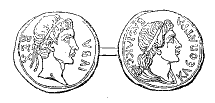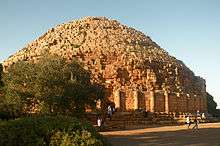Juba II
Juba II or Juba of Mauretania (Latin: Iuba, Juba; Ancient Greek: Ἰóβας, Ἰóβα or Ἰούβας[1], c. 48 BC – AD 23) was the client King of Numidia and Mauretania, succeeding his father Juba I. Aside from his very successful reign, he was a highly respected scholar and author. His first wife was Cleopatra Selene II, daughter of Egyptian Queen Cleopatra VII of Ptolemaic Egypt and Roman Triumvir Mark Antony.
| Juba II | |
|---|---|
 Portrait of Juba II, Louvre Museum | |
| King of Numidia | |
| Reign | 30 BC – 25 BC (5 years) |
| Predecessor | Juba I |
| Successor | Annexed to the Roman Republic/Empire |
| King of Mauretania | |
| Reign | 25 BC – AD 23 (48 years) |
| Successor | Ptolemy of Mauretania |
| Spouse | Cleopatra Selene II Glaphyra of Cappadocia |
| Issue | Ptolemy of Mauretania Drusilla of Mauretania |
| Father | Juba I |
Early life
Juba II was a Berber prince from Numidia. He was born in Hippo Regius (now Annaba, Algeria). He was the only child and heir of King Juba I of Numidia; his mother's identity is unknown. In 46 BC, his father was defeated by Julius Caesar (in Thapsus, North Africa) and in 40 BC Numidia became a Roman province.[1] His father had been an ally of the Roman General Pompey.
Several modern scholars cite his age at Caesar's Triumph in 46 BC as four or six giving rise to the typically cited birth year range of 52-50 BC, which his biographer, Duane Roller, believes is incorrect. Roller instead places his birth in early 48 BC because the Greek term brefos was used for him which means literally fetus but can figuratively mean youth. The word for a child of age 4 to 6 is pais which was not used for him in the ancient sources. Therefore, Roller places his age in the triumph at anywhere from 2 months to 2 years, which actually indicates a birth year range between 48 and 46 BC.[2]
Juba II was brought to Rome by Julius Caesar and he took part in Caesar's triumphal procession. In Rome he learned Latin and Greek, became romanized and was granted Roman citizenship.[1] Through dedication to his studies, he is said to have become one of Rome's best educated citizens, and by age 20 he wrote one of his first works entitled Roman Archaeology.[1] He was raised by Julius Caesar and later by his great-nephew Octavian (future Emperor Augustus). While growing up, Juba II accompanied Octavian on military campaigns, gaining valuable experience as a leader. He fought alongside Octavian in the Battle of Actium in 31 BC.
Restored to the throne

In 30 BC, Octavian restored Juba II as king of Numidia.[3][4] Juba II established Numidia as an ally of Rome. Probably as a result of his services to Augustus in a campaign in Hispania, between 26 BC and 20 BC the Emperor arranged for him to marry Cleopatra Selene II, giving her a large dowry and appointing her queen.[5] In 25 BC, Numidia became a Roman province and Juba II received Mauretania as his kingdom.[3]
Reign in Mauretania
According to Strabo, upon the deaths of the Mauretanian kings Bogus and Bocchus, who were both allies of the Romans, Juba II succeeded to the Mauretanian kingdom, having received it from Augustus, in addition to his paternal dominions.[6] When Juba II and Cleopatra Selene moved to Mauretania, they named their new capital Caesaria (modern Cherchell, Algeria), in honour of Augustus. The construction and sculpture projects at Caesaria and another city, Volubilis, display a rich mixture of Egyptian, Greek and Roman architectural styles.
Cleopatra is said to have exerted considerable influence on Juba II's policies. Juba II encouraged and supported the performing arts, research of the sciences and research of natural history. Juba II also supported Mauretanian trade. The Kingdom of Mauretania was of great importance to the Roman Empire. Mauretania engaged in trade all across the Mediterranean, particularly with Spain and Italy. Mauretania exported fish, grapes, pearls, figs, grain, wooden furniture and purple dye harvested from certain shellfish, which was used in the manufacture of purple stripes for senatorial robes. Juba II sent a contingent to Iles Purpuraires to re-establish the ancient Phoenician dye manufacturing process.[7] Tingis (modern Tangier), a town at the Pillars of Hercules (modern Strait of Gibraltar) became a major trade centre. In Gades, (modern Cádiz) and Carthago Nova (modern Cartagena) in Spain, Juba II was appointed by Augustus as an honorary Duovir (a chief magistrate of a Roman colony or town), probably involving trade, and was also a Patronus Colonaie.
The value and quality of the Mauretanian coinage became highly regarded. The Greek historian Plutarch describes him as 'one of the most gifted rulers of his time'. Between 2 BC and AD 2, he travelled with Gaius Caesar (a grandson of Augustus), as an advisor to the Eastern Mediterranean. In AD 21, Juba II made his son Ptolemy his co-ruler. Juba II died in AD 23. Juba II was buried alongside his first wife in the Royal Mausoleum of Mauretania. Ptolemy then became the sole ruler of Mauretania.
Marriages and children


- First marriage to Greek Ptolemaic princess Cleopatra Selene II (40 BC – 6 AD). Their children were:
- Ptolemy of Mauretania born in ca 10 BC/ 5 BC[8]
- A daughter of Cleopatra and Juba, whose name has not been recorded, is mentioned in an inscription. It has been suggested that Drusilla of Mauretania was that daughter, but she may have been a granddaughter. Drusilla is described as a granddaughter of Antony and Cleopatra, or she may have been a daughter of Ptolemy of Mauretania.[8]
- Second marriage to Glaphyra, a princess of Cappadocia, and widow of Alexander, son of Herod the Great. Alexander was executed in 7 BC for his involvement in a conspiracy against his father. Glaphyra married Juba II in 6 AD or 7 AD. She then fell in love with Herod Archelaus, another son of Herod the Great and Ethnarch of Judea. Glaphyra divorced Juba to marry him in 7 AD. Juba had no children with Glaphyra.
Author
Juba wrote a number of books in Greek and Latin on history, natural history, geography, grammar, painting and theatre. He compiled a comparison of Greek and Roman institutions known as Όμοιότητες (Similarities).[9] His guide to Arabia became a bestseller in Rome. Only fragments of his works survived. He collected a substantial library on a wide variety of topics, which no doubt complemented his own prolific output. Pliny the Elder refers to him as an authority 65 times in the Natural History and in Athens, a monument was built in the Gymnasium of Ptolemy in recognition of his writings.[10][11]
Natural history
Juba II was a noted patron of the arts and sciences and sponsored several expeditions and biological research. He also was a notable author, writing several scholarly and popular scientific works on natural history.
According to Pliny the Younger, Juba II sent an expedition to the Canary Islands and Madeira.[12] Juba II had given the Canary Islands that name because he found particularly ferocious dogs (canarius – from canis – meaning of the dogs in Latin) on the island.
Legacy
Juba's Greek physician Euphorbus wrote that a succulent spurge found in the High Atlas was a powerful laxative.[13] In 12 BC, Juba named this plant Euphorbia after Euphorbus, in response to Augustus dedicating a statue to Antonius Musa, Augustus's own personal physician and Euphorbus's brother.[13] Botanist and taxonomist Carl Linnaeus assigned the name Euphorbia to the entire genus in the physician's honour.[14] Euphorbia was later called Euphorbia regisjubae ("King Juba's euphorbia") to honour the king's contributions to natural history and his role in bringing the genus to notice. It is now Euphorbia regis-jubae. The palm tree genus Jubaea is also named after Juba.
Flavius Philostratus recalled one of his anecdotes: "And I have read in the discourse of Juba that elephants assist one another when they are being hunted, and that they will defend one that is exhausted, and if they can remove him out of danger, they anoint his wounds with the tears of the aloe tree, standing round him like physicians."[15]
Further reading
References
- Roller, Duane W. (2003) The World of Juba II and Kleopatra Selene "Routledge (UK)". p. 1–3. ISBN 0-415-30596-9.
- Roller, Duane W. (2003) The World of Juba II and Kleopatra Selene "Routledge (UK)". p. 59. ISBN 0-415-30596-9.
- Pomponius Mela; Frank E. Romer (1998). Pomponius Mela's Description of the World. University of Michigan Press. p. 43. ISBN 0-472-08452-6.
- Michael Gagarin (2010). The Oxford Encyclopedia of Ancient Greece and Rome. Oxford University Press. p. 80. ISBN 978-0-19-517072-6.
- Roller, Duane W. (2003) The World of Juba II and Kleopatra Selene Routledge (UK)ISBN 0-415-30596-9 p. 74
- Strabo's Geography (Strab. 17.3)
- C.Michael Hogan, Mogador: Promontory Fort, The Megalithic Portal, ed Andy Burnham, November 2, 2007
- Cleopatra Selene Archived 2016-03-03 at the Wayback Machine by Chris Bennett
- F Jacoby, Realencyclopädie der Classischen Altertumswissenschaft, 1916, s.v.
- Elder.), Pliny (the (1857). The Natural History of Pliny. H. G. Bohn.
- Braund, David (2014-04-08). Rome and the Friendly King (Routledge Revivals): The Character of Client Kingship. Routledge. ISBN 978-1-317-80301-0.
- O'Brien, Sally and Sarah Andrews. (2004) Lonely Planet Canary Islands "Lonely Planet". p. 59. ISBN 1-74059-374-X.
- Flowering Plants of the Santa Monica Mountains, p 107, 1985, CNPS
- Linnaeus (1753): p.450
- Flavius Philostratus, Life of Apollonius of Tyana, Loeb Classical Library, Book II, Chapter XVI, translated by F.C. Conybeare
External links
| Wikimedia Commons has media related to Juba II. |
